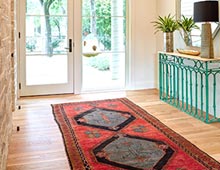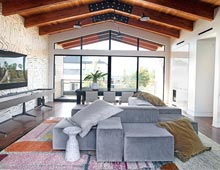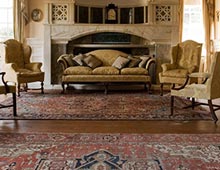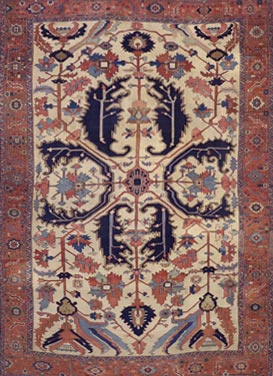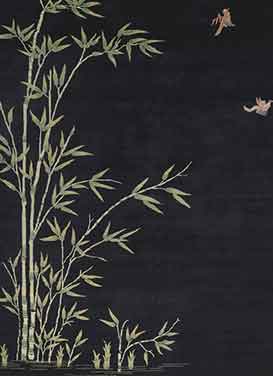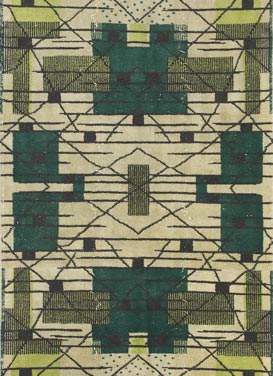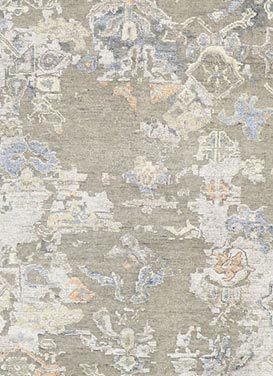Persian Ardabil Rugs

Persian Ardabil Rugs: Timeless Elegance and Rich Tradition
If you're seeking a piece of art that bridges history and design, look no further than Persian Ardabil rugs. Hailing from the picturesque region of Ardabil in Northern Iran, these rugs encapsulate centuries of skill and tradition. Crafted with intricate geometric patterns and boasting knot densities ranging from 100,000 to 250,000 knots per square meter, Persian Ardebil rugs are a testimony to the region's artistic prowess.
What Sets Persian Ardabil Rugs Apart?
Geometric Marvels: Persian Ardabil rugs are renowned for their exquisite geometric patterns, which stem from a rich heritage deeply connected to village and nomadic weaving traditions. These patterns often display a harmonious blend of shapes and lines inspired by Caucasian designs reminiscent of Karabakh, Shirvan, and Gendje.
The most recognized pattern found on Ardabil rugs is the well-known Herati design - a diamond medallion and small fish throughout. Some modern weavers are incorporating bold geometric designs rather than the traditional Herati, and have included colors such as purple, turquoise, orange and green to the more traditional red, pink, ivory, and blue.
A Tale of Materials: The materials used in crafting Persian Ardebil rugs are simple yet exceptional. The pile is made from pure sheep's wool, while cotton serves as the warp. This combination ensures durability and longevity, making these rugs resilient companions for generations.
An Ardabil Masterpiece: The Ardabil Carpet
Among the most celebrated creations from the region is the iconic Ardabil Carpet. This masterpiece, measuring an astounding 34' x 17', resides in the Victoria and Albert Museum in London. Adorned with flowers, leaves, pointed oval shapes and lamp motifs, this carpet represents the pinnacle of Ardabil's weaving legacy.
Preserving History: The Mausoleum Connection
It's believed that the Ardabil Carpet was originally destined for the Mausoleum of Sheikh Safieddin Ardabili. While this theory holds merit, some speculate that it might have been intended as a tribute to the Ottoman Turks. Today, it stands as a timeless symbol of artistry and craftsmanship.
Unique Characteristics of Persian Ardabil Rugs
Beyond their stunning aesthetics, Persian Ardabil rugs bear several distinctive traits:
Intricate Knotting: The knotting technique used in these rugs are Azerbaijani knots. This meticulous process results in dense and tightly packed patterns that are not only visually appealing but also robust.
Distinguishing Patterns: Similar to Caucasian rugs, Ardabil rugs are mostly geometric, but have additional motifs and the colors are also lighter. Ardebil rug layouts are predominantly medallions, allover octagonal shapes, or connected lozenge (diamond) medallions.
Silk Accents: To accentuate the patterns, silk is often incorporated into the wool pile. This touch of luxury adds depth and sheen, enhancing the rug's overall allure.
Architectural Influences: Inspired by the region's architectural wonders, Persian Ardabil rugs sometimes feature motifs resembling the intricate designs found in the domes of mosques and palaces.
Things to Know About Persian Ardabil Rugs:
What is a Persian Ardabil Rug?
A Persian Ardabil rug is a meticulously handcrafted masterpiece originating from the Ardabil region in Northern Iran. Known for their geometric patterns, these rugs showcase the remarkable skill of local weavers and carry a rich cultural heritage.
What is Special About Persian Ardabil Rugs?
Persian Ardabil rugs embody timeless beauty and expert craftsmanship. Their unique blend of intricate geometric designs, high knot density, and durable materials makes them both visually captivating and long-lasting heirlooms.
What is the Persian Ardabil Carpet?
The Persian Ardabil carpet, exemplified by the renowned Ardabil Carpet, is a monumental creation measuring 34' x 17'. Adorned with a signature and inscription, this carpet is a masterpiece that showcases the finest weaving traditions of Ardabil.
Where is the Ardabil Carpet Now?
The Ardabil Carpet resides in the Victoria and Albert Museum in London, where it is displayed as a testament to the region's weaving excellence and artistic legacy.
Who Has the Ardabil Carpet Now?
The Ardabil Carpet is under the care of the Victoria and Albert Museum in London, where it is cherished as a priceless work of art and history.
What is the inscription on the Ardabil Carpet?
The inscription on the Ardabil Carpet reads:
I have no refuge in the world other than thy threshold.
There is no protection for my head other than this door.
The work of the servant of the threshold Maqsud of Kashan in the year 946.
Differences Between Persian Ardabil Rugs and Other Persian Rugs
While Persian Ardabil rugs share the meticulous craftsmanship and design finesse of other Persian rugs, their distinct geometric patterns, use of silk accents, and architectural influences set them apart. The incorporation of Turkish and Persian knotting techniques further contributes to their unique character.
Applied Filters
–
- 3
- 15
–
- 5
- 22
-
-
No items found matching the search criteria
-
-
No items found matching the search criteria
-
-
No items found matching the search criteria
-
-
No items found matching the search criteria
Dimensions
–
- 3
- 15
–
- 5
- 22
-
-
No items found matching the search criteria
-
-
No items found matching the search criteria
-
-
No items found matching the search criteria
-
-
No items found matching the search criteria

